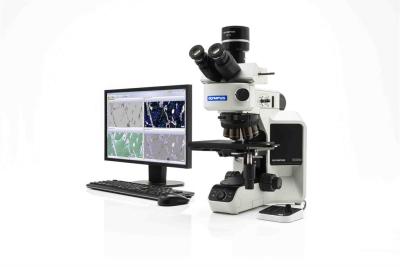
Said to combine ease of use with expanded functionality, the new BX53M System Microscope from Olympus Scientific Solutions Americas is designed to make it easy for users to quickly and accurately undertake a variety of analytical tasks, the company announced in a Jan. 26 news release. What's more, when combined with new Olympus Stream 2.1 Image Analysis Software, the BX53M System Microscope reportedly simplifies workflow from observation to measurement, analysis and reporting.
The system’s user-friendly upright design features easy-to-adjust aperture settings and a new LED illuminator that enables users to change observation methods by turning a dial. A modular construction allows easy adaptation into unique operating environments and provides the ability for custom configuration, the company added.
A host of advanced features make the BX53M the ideal tool for metallurgical analysis:
- The ability to quickly restore previously used settings for repeatable test results.
- Advanced imaging functions including directional darkfield and MIX;
- Directional darkfield illuminates the sample from the side with the ability to control the direction from a handset or Olympus Stream 2.1, and
- MIX combines directional darkfield with brightfield, polarized light, or fluorescence, providing new ways to see features.
- A 150mm x 100mm flat-top stage accommodates larger samples.
The Olympus Stream 2.1 Image Analysis Software modules use an intuitive interface that guides users through every step of the imaging process, making complex tasks more efficient through a range of advanced features:
- Seamless pairing with Olympus coded hardware including the BX53M,
- Straightforward interface with step-by-step user guidance,
- Instant EFI creates 3D images and allows precise height measurement on the profile,
- Quick recall of previous settings for excellent reproducibility, and
- Detailed, customized reports.
Contact Details
Related Glossary Terms
- modular design ( modular construction)
modular design ( modular construction)
Manufacturing of a product in subassemblies that permits fast and simple replacement of defective assemblies and tailoring of the product for different purposes. See interchangeable parts.
- turning
turning
Workpiece is held in a chuck, mounted on a face plate or secured between centers and rotated while a cutting tool, normally a single-point tool, is fed into it along its periphery or across its end or face. Takes the form of straight turning (cutting along the periphery of the workpiece); taper turning (creating a taper); step turning (turning different-size diameters on the same work); chamfering (beveling an edge or shoulder); facing (cutting on an end); turning threads (usually external but can be internal); roughing (high-volume metal removal); and finishing (final light cuts). Performed on lathes, turning centers, chucking machines, automatic screw machines and similar machines.






